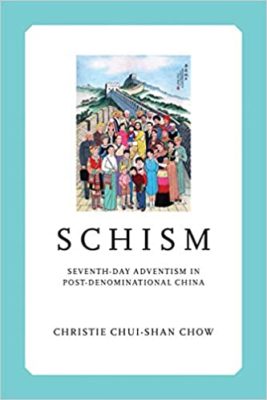Schism: Seventh-day Adventism in Post-Denominational China by Christie Chow. University of Notre Dame Press, 2021, 352 pages. ISBN-10 0268200521; ISBN-13 978-0268200521; 9780268200541 (eBook EPUB). Available from Amazon and University of Notre Dame Press.
Christie Chow in Schism addresses an elusive question: What happened to the Protestant denominations in China after 1949?
Designing an innovative new direction for research into Chinese Christianity, Christie Chow focuses on one church family, the Seventh-day Adventists. At the same time, she interacts effortlessly with the burgeoning contemporary scholarship, placing this study on the cutting edge of Chinese church studies. The denominations have not completely disappeared, rather the Adventists continue to “retain, revive, and recast their unique ecclesial identity in a religious habitat that resists diversity” (back cover).
Schism grew out of Chow’s doctoral dissertation at Princeton Theological Seminary, supervised by Richard Fox Young, and is published by Notre Dame Press. The back cover boasts the heavy-hitting endorsements of Chloe Starr and Lars Laamann. The impressive bibliography runs for over twenty-five pages, and includes archives in Michigan, Hong Kong, California, and Wenzhou, China. Chow incorporates the personal papers and diaries of about eleven people in China, as well as over a dozen church magazines. The abundant list includes a good mix of Chinese and key English monographs, citing scholars such as Lamin Sanneh, C.K. Yang, and Philip Jenkins. There is a helpful index, an appendix of an Adventist hymnal, as well as a glossary that provides the Chinese characters to the romanized Chinese words in the text.
Schism is divided into seven chapters, starting with the history of Adventism in China, and concluding with several case studies of recent Adventist developments and divisions. Chapter 1 introduces Ellen G. White and the birth of the Adventist movement as well as the arrival of Adventism in China, particularly in Wenzhou, a primary focus of the research. In addition to attracting non-Christians, the Adventists offered Chinese Christians a “more authentic day of Sabbath observance,” thereby “one might say that the Adventists were making themselves competitive with other denominations by introducing a new approach to salvation on Earth” (p. 41). The Adventist missionaries, disavowing the various comity agreements among other missionaries, enjoyed “considerable freedom to evangelize wherever they could win potential converts” (p. 43). The chapter also follows the development and indigenization of the Adventist churches in Wenzhou from the 1940s to the 1970s.
Chapter 2 turns to the “first schism,” a division that arose in 1978 from the decision to allow conflicting Adventist churches to continue to follow the style of prayer in Sabbath worship they preferred. By the 1990s, the divergent approaches toward Sabbath worship had developed into two distinct provincial networks. These distinct approaches had emerged and were intensified throughout the era of clandestine meetings during the Cultural Revolution and persisted through the post-Mao era. The divisions continued to fester, and by the 1990s were joined by external mediators as China opened to the outside world. Nonetheless, the “conservatives” and the “reformist” factions failed to compromise, and the schism persisted.
Chapter 3 focuses on the “Wilderness Schism,” and Chapter 4 turns to the “Wheatfield Schism.” These stories of the schisms within Adventism continue to show how the church interacted with both their external context as well as negotiating internal struggles and doctrinal controversies.
Chapter 5 explores the tension women experience in a particular village called “Horizontal Dyke Village,” and Chapter 6, “Divide and Divide,” follows the first and the second division of the church in Stone Ground Village, and then analyzes why the union attempt failed to bring the factions together. Chapter 7, “A Brief Coalition,” concludes with the case of South Pond. The study examines a recent case in which the divided Adventists were able to cooperate in a legal case which was ultimately decided against them in 2015. They appealed to the provincial court in 2016, but they were denied and the cooperation between the factions dissipated.
The study displays the academic rigor and meticulous research of a PhD dissertation but is engaging with lively case studies. Christie Chow shows that Protestant denominations not only survived the Mao era but persist today. As they have continued to negotiate their context, the denominations, at least the Seventh-day Adventists in Wenzhou, endured. With her groundbreaking research, Chow pioneers a new approach to studying Christianity in China.
The decision to research the Seventh-day Adventists is both inspired and problematic. Adventists are a unique expression of Protestantism, and thus they tend to remain aloof from other Protestant expressions. In China, that makes them an ideal subject for this project. They have maintained, as best they can, their distinctives, and the contextualization of the churches over time can be readily identified. However, further research on other denominations, such as the Methodists, or nondenominational missions, like the China Inland Mission, might produce less satisfying results.
Nonetheless, Chow succeeds in expanding on three theoretical and methodological considerations (p. 226-228). First, she demonstrates that the term “schism” can be used heuristically; a schism, as seen in the case of the Adventists in China, can be a catalyst of revival and renewal. Next, she shows that beyond personal, social, and political considerations, schism and renewal can be driven by theological factors. Chow explains, “Here, theology becomes a discourse of interpretive analysis that rationalizes their choices and actions and must therefore be taken seriously by the researcher” (p. 227). Third, the book demonstrates “the merits of ethnographic inquiry in capturing and diagnosing the complexity of contemporary Chinese religious life” (p. 227). She provides a framework for future researchers to create a richer and more nuanced understanding of the nature of Chinese Christianity.
China is not a monolith, and historians for decades have been showing that regional and local studies can produce particularly satisfying insights and conclusions. Christianity in China has not progressed evenly in all regions, and localized research helps explain why certain parts of China have experienced more Christian growth than others. Christie Chow now demonstrates that assorted religious and denominational commitments can also profoundly influence the development and success of Christianity in China.

Richard Cook
Richard Cook is Associate Professor of Church History and Missions at Logos Evangelical Seminary in El Monte, California and serves as Director of the M.A.I.C.S. Program. He came to Logos in 2011. Dr. Cook served as a missionary and seminary professor in Taiwan for over ten years, and before coming …View Full Bio
Are you enjoying a cup of good coffee or fragrant tea while reading the latest ChinaSource post? Consider donating the cost of that “cuppa” to support our content so we can continue to serve you with the latest on Christianity in China.
